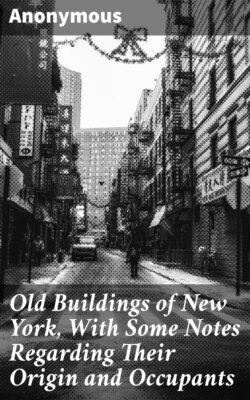Читать книгу Old Buildings of New York, With Some Notes Regarding Their Origin and Occupants - Anonymous - Страница 4
На сайте Литреса книга снята с продажи.
ОглавлениеNumber Seven State Street
Table of Contents
This house was built by Moses Rogers, a prominent merchant of the latter part of the eighteenth and the first part of the nineteenth century. He was a native of Connecticut, his mother being a daughter of Governor Fitch of that State. He was in business as early as 1785 at 26 Queen (Pearl) Street. In 1793 the firm name was Rogers & Woolsey, his partner being William Walter Woolsey, his brother-in-law, Mr. Rogers having married Sarah Woolsey, a sister of the wife of President Dwight of Yale College. In that year he was living at 272 Pearl Street, near Beekman, “in a large house with hanging garden extending over the yard and stable.”6
Mr. Rogers was a merchant of high character and public spirit. In 1793 he was an active member of the Society for the Manumission of Slaves. He was a governor of the New York Hospital from 1792 to 1799, and in 1797 treasurer of the City Dispensary. From 1787 until 1811 he was a vestryman of Trinity Church, and in 1793 was a member of the Society for the Relief of Distressed Prisoners.7
In the year 1806 he was living in the house here presented. His sister had married the celebrated merchant and ship owner, Archibald Gracie. His children were: (1) Sarah E. Rogers, who married the Hon. Samuel M. Hopkins; (2) Benjamin Woolsey Rogers, who married Susan, daughter of William Bayard; (3) Archibald Rogers, who married Anna, daughter of Judge Nathaniel Pendleton; and (4) Julia A. Rogers, who married Francis Bayard Winthrop.8 In the year 1826 Benjamin Woolsey Rogers was living in the next house, Number Five State Street, but after his father’s death he moved to Number Seven and lived there until 1830.9 William P. Van Rensselaer, grandson of General Stephen Van Rensselaer, married successively two of the daughters of Mr. Rogers. The house during the ownership of the Rogers family was the scene of many notable entertainments. These entertainments were frequently referred to by older members of society who have now passed away. In 1830 the house was occupied by Gardiner G. Howland.
The queerly shaped front was to a certain extent a necessity. State Street takes a sharp turn and the house was built at the apex of an angle. The interior was doubtless an improvement on other houses. The ceilings were high, and the staircase, instead of being in the hall as in older houses, is at the side. It is winding, of an oval design, with mahogany balustrade. The skylight was of stained glass, made in England, showing the coat of arms.
During the Civil War, the house was taken by the Government for military uses, and afterwards became the office of the Pilot Commissioners.
It is now the house of the mission of Our Lady of the Rosary.
